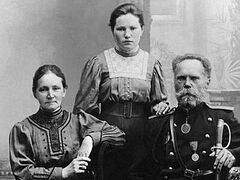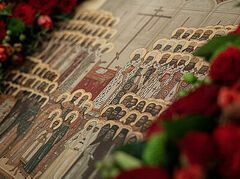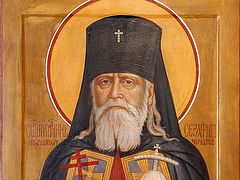The land of Kasimov [a picturesque medieval town on the Oka River in the Ryazan region; formerly the capital of the Tatar-ruled Qasim Khanate, a vassal of Russia.—Trans.] is famous for its strugglers of piety, one of whom was Blessed Prince Yakov (James), grandson of the Muslim Khan Arslan of Kasimov (†1626) and his wife Fatima (†1681), who according to legend was a secret Christian. Yakov’s father, Vasily Arslanovich (1624–1679), having been baptized with the name Vasily, brought up his children in piety and taught them mercy. Orthodox churches were built and adorned under him. Vasily especially supported the local Convent in honor of the Kazan Icon of the Mother of God because of the miraculous healing of his son Yakov after a prayer service in front of the wonderworking Kazan Icon that was kept there.
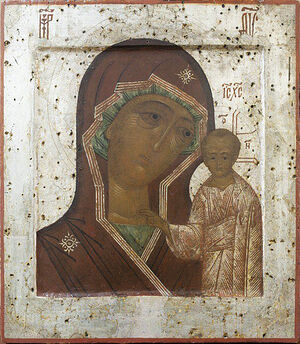 The Kasimov Kazan Icon of The Mother of God Iakov Vasilievich donated all of his inheritance to the Kazan Convent. The young Christian’s great generosity enraged the local Tatars, who one day attacked and beat him violently. Prince Yakov died on January 7/20, 1677 aged about twenty-five. The cause of his death remained unknown; according to one version, the young man was poisoned by his Muslim relatives. He was buried near the convent’s Church of the Kazan Icon of the Mother of God. A chapel was built over his grave, and from that time on devotees and pilgrims from all over Russia flocked to the grave of the blessed innocent sufferer with their sorrows, where numerous healings and other miracles occurred.
The Kasimov Kazan Icon of The Mother of God Iakov Vasilievich donated all of his inheritance to the Kazan Convent. The young Christian’s great generosity enraged the local Tatars, who one day attacked and beat him violently. Prince Yakov died on January 7/20, 1677 aged about twenty-five. The cause of his death remained unknown; according to one version, the young man was poisoned by his Muslim relatives. He was buried near the convent’s Church of the Kazan Icon of the Mother of God. A chapel was built over his grave, and from that time on devotees and pilgrims from all over Russia flocked to the grave of the blessed innocent sufferer with their sorrows, where numerous healings and other miracles occurred.
In the twentieth century, Vera Nikolaevna Samsonova, a teacher, was involved in perpetuating the memory of the pious prince of Kasimov. Vera was born in the village of Veryayevo, the Ryazan region, in 1880. She graduated from the Kasimov Women’s Grammar School with honors and began to work as a teacher at the school. Meanwhile, atheist propaganda was gaining momentum: all the icons were taken out of the school. Unable to put up with this, Vera resigned from the school.
The Kasimov convent had been closed by that time, but there was the active Church of Great-Martyr Parasceva (or, more exactly, of the Nativity of the Theotokos) on its site, where Vera Samsonova was elected churchwarden. Priest Nikolai Pravdolyubov (1892–1941), the future hieromartyr, was the rector there. Batiushka was collecting miracles occurred through the prayers of Prince Yakov of Kasimov, funeral services were sung at his grave, and Vera Nikolaevna would pray together with sick people at the chapel of the blessed prince and anoint them with oil from icon lamps.
Fr. Nikolai decided to compile a book about the local ascetics: Eldress Justina (the foundress and the first abbess of the convent from 1627), Prince Yakov, Elder Peter Semyonovich the Hermit (1714–1847) and Blessed Matrona of Anemnyasevo (1864–1936), who was still alive. Vera helped Fr. Nikolai prepare this book. Out of his naivety and simplicity Fr. Nikolai gave it to a fellow villager, an intellectual, to read. So the book got into the hands of the NKVD (the People’s Commissariat for the Internal Affairs).
 Vera Nikolaevna Samsonova. A photo of the 1920s In the summer of 1935, for honoring the memory of the blessed prince of Kasimov and St. Matrona of Anemnyasevo, NKVD officers arrested some priests and laypeople—among them was Vera Nikolaevna.
Vera Nikolaevna Samsonova. A photo of the 1920s In the summer of 1935, for honoring the memory of the blessed prince of Kasimov and St. Matrona of Anemnyasevo, NKVD officers arrested some priests and laypeople—among them was Vera Nikolaevna.
Cheka (an organization for the investigation of counterrevolutionary activities) officers left an interesting description of the confessor: “She is religious to the point of fanaticism. She makes her livelihood by teaching the Law of God... She attends church daily and distributes prosphora among the faithful...”
It is amazing how straightforward and courageous Vera Nikolaevna was during the interrogation: “As a believer I see open violence against religion and believers, manifested in the form of forcible—in defiance of the will of the faithful—closure of churches and their destruction, a blasphemous attitude towards Christian shrines, arrests and the exile of innocent clergy and believers...”
The zealous ascetic was sentenced to five years in labor camps. For two years the sufferer languished at the Solovki Special Purpose Camp. After Solovki, Vera Nikolaevna served at the Sosnovets Camp in Karelia for over two years.
Unbearable conditions and hard labor emaciated the sufferer: Vera fell ill and ended up in the central infirmary. On June 14, 1940, at the age of fifty-nine, the martyr commended her righteous soul to God.
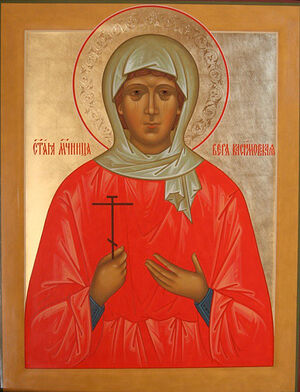 Icon of New Martyr Vera of Kasimov Vera Nikolaevna was at the Solovki Camp together with the holy New Martyr Anatoly Pravdolyubov (1862–1937), who recalled: “The Lord came to love her especially, and she died peacefully the day before her release. She was a woman who devoted herself entirely to God. She became the bride of the Heavenly Bridegroom, Christ, from her youth and, undoubtedly, was crowned by Him with an incorruptible martyr’s crown, so we can surely pray to her... as to an intercessor before God for us who have not yet ended our earthly paths and are in need of continuous spiritual support.”
Icon of New Martyr Vera of Kasimov Vera Nikolaevna was at the Solovki Camp together with the holy New Martyr Anatoly Pravdolyubov (1862–1937), who recalled: “The Lord came to love her especially, and she died peacefully the day before her release. She was a woman who devoted herself entirely to God. She became the bride of the Heavenly Bridegroom, Christ, from her youth and, undoubtedly, was crowned by Him with an incorruptible martyr’s crown, so we can surely pray to her... as to an intercessor before God for us who have not yet ended our earthly paths and are in need of continuous spiritual support.”
The holy New Martyr Vera is venerated at Solovki Monastery and at the Dormition Convent of Vysha in the Ryazan region as the patron-saint of Abbess Vera (Rovchan).

